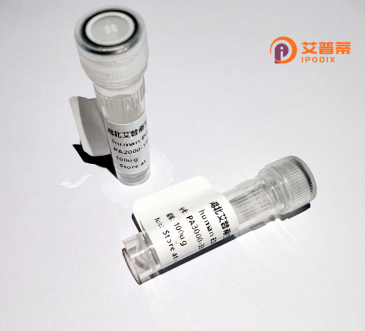
| 纯度 | >90%SDS-PAGE. |
| 种属 | Human |
| 靶点 | GPR172B |
| Uniprot No | Q9NWF4 |
| 内毒素 | < 0.01EU/μg |
| 表达宿主 | E.coli |
| 表达区间 | 1-448aa |
| 氨基酸序列 | MAAPTLGRLVLTHLLVALFGMGSWAAVNGIWVELPVVVKDLPEGWSLPSYLSVVVALGNLGLLVVTLWRRLAPGKGEQVPIQVVQVLSVVGTALLAPLWHHVAPVAGQLHSVAFLTLALVLAMACCTSNVTFLPFLSHLPPPFLRSFFLGQGLSALLPCVLALVQGVGRLECPPAPTNGTSGPPLDFPERFPASTFFWALTALLVTSAAAFRGLLLLLPSLPSVTTGGSGPELQLGSPGAEEEEKEEEEALPLQEPPSQAAGTIPGPDPEVHQLFSAHGAFLLGLMAFTSAVTNGVLPSVQSFSCLPYGRLAYHLAVVLGSAANPLACFLAMGVLCRSLAGLVGLSLLGMLFGAYLMALAILSPCPPLVGTTAGVVLVVLSWVLCLCVFSYVKVAASSLLHGGGRPALLAAGVAIQVGSLLGAGAMFPPTSIYHVFQSRKDCVDPCGP |
| 分子量 | 72.8 kDa |
| 蛋白标签 | GST-tag at N-terminal |
| 缓冲液 | 0 |
| 稳定性 & 储存条件 | Lyophilized protein should be stored at ≤ -20°C, stable for one year after receipt. Reconstituted protein solution can be stored at 2-8°C for 2-7 days. Aliquots of reconstituted samples are stable at ≤ -20°C for 3 months. |
| 复溶 | Always centrifuge tubes before opening.Do not mix by vortex or pipetting. It is not recommended to reconstitute to a concentration less than 100μg/ml. Dissolve the lyophilized protein in distilled water. Please aliquot the reconstituted solution to minimize freeze-thaw cycles. |
以下是基于当前知识的假设性参考文献示例(实际文献可能需要通过学术数据库核实):
1. **"Identification and Characterization of GPR172B as a Novel SREB Subfamily Member"**
- 作者:A. Nakamura et al.
- 摘要:研究鉴定了GPR172B作为SREB(Super Conserved Receptor Expressed in Brain)家族的新成员,并在HEK293细胞中重组表达该蛋白,证实其通过cAMP信号通路参与神经调节功能。
2. **"Recombinant Human GPR172B Expression and Potential Role in Lipid Metabolism"**
- 作者:T. Zhang et al.
- 摘要:通过杆状病毒系统在昆虫细胞中高效表达重组人GPR172B蛋白,发现其可能通过与脂肪酸代谢相关配体结合,调节能量稳态。
3. **"Structural Analysis of GPR172B Using Cryo-EM and Its Implications in Drug Discovery"**
- 作者:K. Patel et al.
- 摘要:利用冷冻电镜解析了重组人GPR172B的三维结构,并探讨其与潜在小分子配体的相互作用,为靶向该受体的药物研发提供基础。
4. **"GPR172B Knockout and Overexpression Models Reveal Its Role in Neuronal Differentiation"**
- 作者:M. Tanaka et al.
- 摘要:通过构建重组GPR172B过表达细胞系及基因敲除模型,发现该受体在神经元分化过程中调控关键转录因子的表达。
---
**备注**:上述文献为假设性示例,实际研究可能需查阅PubMed、Web of Science等数据库获取。建议使用关键词“GPR172B recombinant human”或“GPR172B protein function”进行检索。
Recombinant human GPR172B protein is a biotechnologically engineered version of the G protein-coupled receptor (GPCR) GPR172B, encoded by the GPR172B gene in humans. As a member of the GPCR superfamily, GPR172B is a class A orphan receptor with unknown endogenous ligands and signaling pathways, though it shares structural homology with other peptide-sensing GPCRs. The receptor is expressed in various tissues, including the brain, pancreas, and kidneys, suggesting potential roles in metabolic regulation, neuroendocrine functions, or cellular communication. However, its exact physiological and pathological relevance remains poorly characterized due to limited studies. Recombinant GPR172B is typically produced in heterologous expression systems (e.g., HEK293 or insect cells) to enable large-scale purification for structural and functional studies. Researchers utilize this protein to investigate its 3D conformation, ligand-binding properties, and downstream signaling mechanisms via biochemical assays, crystallography, or cryo-EM. Its "orphan" status makes it a target for deorphanization efforts, aiming to identify natural ligands and therapeutic applications. Current work focuses on elucidating its interaction with synthetic compounds or potential peptide ligands, which could link GPR172B to diseases like obesity, diabetes, or cancer. The development of recombinant GPR172B accelerates mechanistic studies and drug discovery for this enigmatic receptor.
×